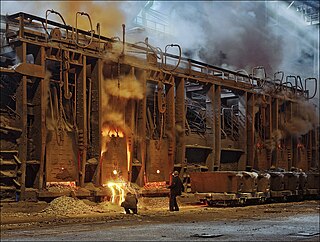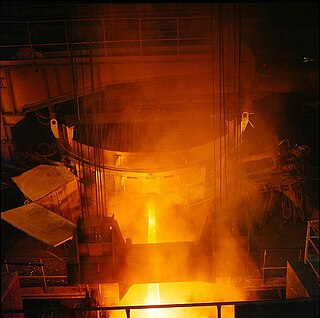Related Research Articles

A cathode-ray tube (CRT) is a vacuum tube containing one or more electron guns, which emit electron beams that are manipulated to display images on a phosphorescent screen. The images may represent electrical waveforms on an oscilloscope, a frame of video on an analog television set (TV), digital raster graphics on a computer monitor, or other phenomena like radar targets. A CRT in a TV is commonly called a picture tube. CRTs have also been used as memory devices, in which case the screen is not intended to be visible to an observer. The term cathode ray was used to describe electron beams when they were first discovered, before it was understood that what was emitted from the cathode was a beam of electrons.

Steelmaking is the process of producing steel from iron ore and/or scrap. In steelmaking, impurities such as nitrogen, silicon, phosphorus, sulfur, and excess carbon are removed from the sourced iron, and alloying elements such as manganese, nickel, chromium, carbon, and vanadium are added to produce different grades of steel.

Brazing is a metal-joining process in which two or more metal items are joined by melting and flowing a filler metal into the joint, with the filler metal having a lower melting point than the adjoining metal.
An electron gun is an electrical component in some vacuum tubes that produces a narrow, collimated electron beam that has a precise kinetic energy.

Induction heating is the process of heating electrically conductive materials, namely metals or semi-conductors, by electromagnetic induction, through heat transfer passing through an inductor that creates an electromagnetic field within the coil to heat up and possibly melt steel, copper, brass, graphite, gold, silver, aluminum, or carbide.

Electron-beam welding (EBW) is a fusion welding process in which a beam of high-velocity electrons is applied to two materials to be joined. The workpieces melt and flow together as the kinetic energy of the electrons is transformed into heat upon impact. EBW is often performed under vacuum conditions to prevent dissipation of the electron beam.
Since the mid-20th century, electron-beam technology has provided the basis for a variety of novel and specialized applications in semiconductor manufacturing, microelectromechanical systems, nanoelectromechanical systems, and microscopy.

An X-ray tube is a vacuum tube that converts electrical input power into X-rays. The availability of this controllable source of X-rays created the field of radiography, the imaging of partly opaque objects with penetrating radiation. In contrast to other sources of ionizing radiation, X-rays are only produced as long as the X-ray tube is energized. X-ray tubes are also used in CT scanners, airport luggage scanners, X-ray crystallography, material and structure analysis, and for industrial inspection.
Ultra-high vacuum is the vacuum regime characterised by pressures lower than about 1×10−6 pascals. UHV conditions are created by pumping the gas out of a UHV chamber. At these low pressures the mean free path of a gas molecule is greater than approximately 40 km, so the gas is in free molecular flow, and gas molecules will collide with the chamber walls many times before colliding with each other. Almost all molecular interactions therefore take place on various surfaces in the chamber.

An open-hearth furnace or open hearth furnace is any of several kinds of industrial furnace in which excess carbon and other impurities are burnt out of pig iron to produce steel. Because steel is difficult to manufacture owing to its high melting point, normal fuels and furnaces were insufficient for mass production of steel, and the open-hearth type of furnace was one of several technologies developed in the nineteenth century to overcome this difficulty. Compared with the Bessemer process, which it displaced, its main advantages were that it did not expose the steel to excessive nitrogen, was easier to control, and permitted the melting and refining of large amounts of scrap iron and steel.
The plasma window is a technology that fills a volume of space with plasma confined by a magnetic field. With current technology, this volume is quite small and the plasma is generated as a flat plane inside a cylindrical space.

An electric arc furnace (EAF) is a furnace that heats material by means of an electric arc.

A foundry is a factory that produces metal castings. Metals are cast into shapes by melting them into a liquid, pouring the metal into a mold, and removing the mold material after the metal has solidified as it cools. The most common metals processed are aluminum and cast iron. However, other metals, such as bronze, brass, steel, magnesium, and zinc, are also used to produce castings in foundries. In this process, parts of desired shapes and sizes can be formed.
Electron-beam physical vapor deposition, or EBPVD, is a form of physical vapor deposition in which a target anode is bombarded with an electron beam given off by a charged tungsten filament under high vacuum. The electron beam causes atoms from the target to transform into the gaseous phase. These atoms then precipitate into solid form, coating everything in the vacuum chamber with a thin layer of the anode material.
Vacuum induction melting (VIM) utilizes electric currents to melt metal within a vacuum. The first prototype was developed in 1920. Induction heating induces eddy currents within conductors. Eddy currents create heating effects to melt the metal. Vacuum induction melting has been used in both the aerospace and nuclear industries.

Evaporation is a common method of thin-film deposition. The source material is evaporated in a vacuum. The vacuum allows vapor particles to travel directly to the target object (substrate), where they condense back to a solid state. Evaporation is used in microfabrication, and to make macro-scale products such as metallized plastic film.
Electron-beam additive manufacturing, or electron-beam melting (EBM) is a type of additive manufacturing, or 3D printing, for metal parts. The raw material is placed under a vacuum and fused together from heating by an electron beam. This technique is distinct from selective laser sintering as the raw material fuses have completely melted. Selective Electron Beam Melting (SEBM) emerged as a powder bed-based additive manufacturing (AM) technology and was brought to market in 1997 by Arcam AB Corporation headquartered in Sweden.
Electron-beam machining (EBM) is a process where high-velocity electrons concentrated into a narrow beam that are directed towards the work piece, creating heat and vaporizing the material. EBM can be used for very precise cutting or boring of a wide variety of metals. Surface finish is better and kerf width is narrower than those for other thermal cutting processes.
Electron-beam freeform fabrication (EBF3) is an additive manufacturing process that builds near-net-shape parts. It requires far less raw material and finish machining than traditional manufacturing methods. EBF3 is done in a vacuum chamber where an electron beam is focused on a constantly feeding source of metal, which is melted and applied as called for by a three-dimensional layered drawing - one layer at a time - on top of a rotating metallic substrate until the part is complete.

Mishra Dhatu Nigam Limited is a metals and metal alloys manufacturing facility in Hyderabad, Telangana, India. It operates as a Public Sector Undertaking (PSU) under the administrative control of Department of Defence Production Ministry of Defence, Government of India. MIDHANI is the only producer of titanium in India.
References
- ↑ "Archived copy" (PDF). www.investquest.com. Archived from the original (PDF) on 31 July 2007. Retrieved 20 July 2022.
{{cite web}}: CS1 maint: archived copy as title (link) - ↑ "What Causes Furnace's High Limit Switch to Keep Tripping?". 2024-03-05. Retrieved 2024-04-18.
- ↑ Technologies, ALD Vacuum. "Electron Beam Melting (EB) - ALD Vacuum Technologies". web.ald-vt.de. Archived from the original on 2017-10-09. Retrieved 2017-10-08.